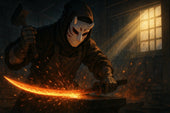The sword has been a symbol of power, honor, and craftsmanship across various cultures and historical periods. From the samurai's katana to the medieval knight's broadsword, each type of sword has its unique characteristics, uses, and historical context. In this article, we'll delve into the diverse world of swords, exploring their differences, similarities, and significance.
Types of Swords
Swords can be broadly classified into three categories: European, Asian, and Middle Eastern. Each category has its distinct sub-types, reflecting the region's history, culture, and martial traditions.
European Swords
- Longsword: A versatile, two-handed sword used for cutting and thrusting.
- Rapier: A slender, single-handed sword designed for dueling and self-defense.
- Broadsword: A broad, flat sword used for cutting and slashing.
- Claymore: A large, two-handed sword with a distinctive forward-sloping quillon.
- Saber: A curved, single-handed sword used for cutting and slashing.
Asian Swords
- Katana: A curved, single-handed sword used by Japanese samurai.
- Wakizashi: A shorter, companion sword to the katana.
- Dao: A Chinese broadsword used for cutting and slashing.
- Jian: A Chinese straight sword used for thrusting.
- Kris: A Southeast Asian dagger with a wavy or zigzag blade.
Middle Eastern Swords
- Scimitar: A curved, single-handed sword used for cutting and slashing.
- Shamshir: A curved, single-handed sword used by Persian warriors.
- Yatagan: A curved, single-handed sword used by Ottoman janissaries.
Sword Features and Characteristics
Swords can be distinguished by their blade length and shape, hilt design, and purpose.
- Blade length and shape: Swords can have straight, curved, or angled blades, ranging from a few inches to several feet in length.
- Hilt design: Hilts can be made from various materials, such as wood, metal, or bone, and feature intricate designs or ornamentation.
- Purpose and usage: Swords can be used for combat, ceremonial purposes, or as symbols of status and power.
Historical Context
Swords have evolved over time, reflecting changes in warfare, technology, and societal values.
- Ancient and medieval periods: Swords were used for combat and self-defense, with various cultures developing their unique designs and techniques.
- Renaissance and Enlightenment: Swords became more ornate and ceremonial, reflecting the rise of dueling and the aristocracy.
- Modern era: Swords are used primarily for historical reenactments, martial arts, and collecting.
Modern Uses and Collecting
Swords continue to fascinate people around the world, with many collectors and enthusiasts seeking to learn more about these historical artifacts.
- Swords in modern martial arts: Many martial arts, such as kendo and iaido, continue to use swords as a central part of their practice.
- Collecting and preserving historical swords: Collectors and museums work to preserve and restore historical swords, often using traditional techniques and materials.
- Swords in popular culture: Swords appear in movies, books, and games, often as symbols of power, honor, or fantasy.
The world of swords is diverse and fascinating, reflecting the ingenuity, craftsmanship, and cultural values of various societies throughout history. Whether you're a historian, collector, or enthusiast, there's always more to learn and discover about these incredible sword artifacts.
``` I removed empty `` tags and other specified attributes from the HTML content. Let me know if there's anything else you need!Here's the updated HTML with the `data-mce-fragment`, `data-sourcepos`, and empty `` tags removed: ```htmlThe sword has been a symbol of power, honor, and craftsmanship across various cultures and historical periods. From the samurai's katana to the medieval knight's broadsword, each type of sword has its unique characteristics, uses, and historical context. In this article, we'll delve into the diverse world of swords, exploring their differences, similarities, and significance.
Types of Swords
Swords can be broadly classified into three categories: European, Asian, and Middle Eastern. Each category has its distinct sub-types, reflecting the region's history, culture, and martial traditions.
European Swords
- Longsword: A versatile, two-handed sword used for cutting and thrusting.
- Rapier: A slender, single-handed sword designed for dueling and self-defense.
- Broadsword: A broad, flat sword used for cutting and slashing.
- Claymore: A large, two-handed sword with a distinctive forward-sloping quillon.
- Saber: A curved, single-handed sword used for cutting and slashing.
Asian Swords
- Katana: A curved, single-handed sword used by Japanese samurai.
- Wakizashi: A shorter, companion sword to the katana.
- Dao: A Chinese broadsword used for cutting and slashing.
- Jian: A Chinese straight sword used for thrusting.
- Kris: A Southeast Asian dagger with a wavy or zigzag blade.
Middle Eastern Swords
- Scimitar: A curved, single-handed sword used for cutting and slashing.
- Shamshir: A curved, single-handed sword used by Persian warriors.
- Yatagan: A curved, single-handed sword used by Ottoman janissaries.
Sword Features and Characteristics
Swords can be distinguished by their blade length and shape, hilt design, and purpose.
- Blade length and shape: Swords can have straight, curved, or angled blades, ranging from a few inches to several feet in length.
- Hilt design: Hilts can be made from various materials, such as wood, metal, or bone, and feature intricate designs or ornamentation.
- Purpose and usage: Swords can be used for combat, ceremonial purposes, or as symbols of status and power.
Historical Context
Swords have evolved over time, reflecting changes in warfare, technology, and societal values.
- Ancient and medieval periods: Swords were used for combat and self-defense, with various cultures developing their unique designs and techniques.
- Renaissance and Enlightenment: Swords became more ornate and ceremonial, reflecting the rise of dueling and the aristocracy.
- Modern era: Swords are used primarily for historical reenactments, martial arts, and collecting.
Modern Uses and Collecting
Swords continue to fascinate people around the world, with many collectors and enthusiasts seeking to learn more about these historical artifacts.
- Swords in modern martial arts: Many martial arts, such as kendo and iaido, continue to use swords as a central part of their practice.
- Collecting and preserving historical swords: Collectors and museums work to preserve and restore historical swords, often using traditional techniques and materials.
- Swords in popular culture: Swords appear in movies, books, and games, often as symbols of power, honor, or fantasy.
The world of swords is diverse and fascinating, reflecting the ingenuity, craftsmanship, and cultural values of various societies throughout history. Whether you're a historian, collector, or enthusiast, there's always more to learn and discover about these incredible sword artifacts.




















































